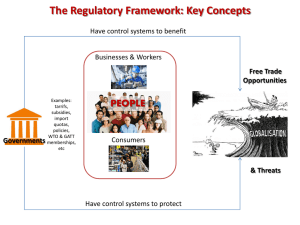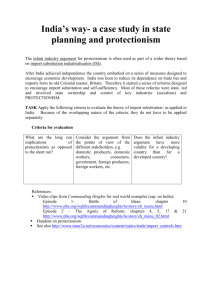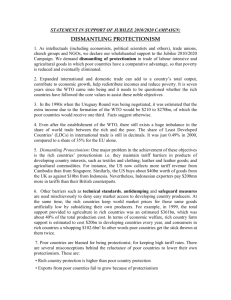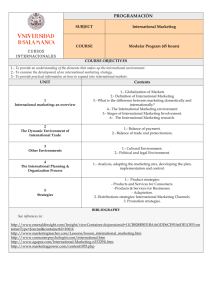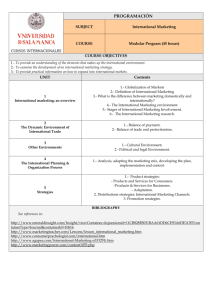Who is the beneficiary of Trade Protectionism
advertisement
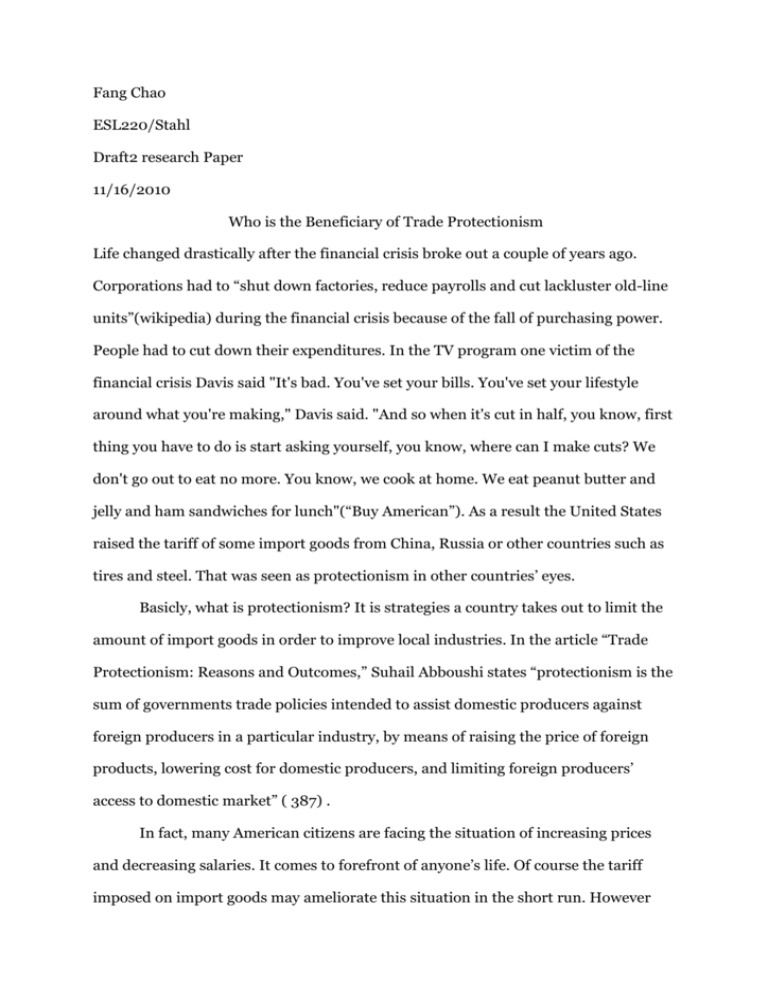
Fang Chao ESL220/Stahl Draft2 research Paper 11/16/2010 Who is the Beneficiary of Trade Protectionism Life changed drastically after the financial crisis broke out a couple of years ago. Corporations had to “shut down factories, reduce payrolls and cut lackluster old-line units”(wikipedia) during the financial crisis because of the fall of purchasing power. People had to cut down their expenditures. In the TV program one victim of the financial crisis Davis said "It's bad. You've set your bills. You've set your lifestyle around what you're making," Davis said. "And so when it's cut in half, you know, first thing you have to do is start asking yourself, you know, where can I make cuts? We don't go out to eat no more. You know, we cook at home. We eat peanut butter and jelly and ham sandwiches for lunch"(“Buy American”). As a result the United States raised the tariff of some import goods from China, Russia or other countries such as tires and steel. That was seen as protectionism in other countries’ eyes. Basicly, what is protectionism? It is strategies a country takes out to limit the amount of import goods in order to improve local industries. In the article “Trade Protectionism: Reasons and Outcomes,” Suhail Abboushi states “protectionism is the sum of governments trade policies intended to assist domestic producers against foreign producers in a particular industry, by means of raising the price of foreign products, lowering cost for domestic producers, and limiting foreign producers’ access to domestic market” ( 387) . In fact, many American citizens are facing the situation of increasing prices and decreasing salaries. It comes to forefront of anyone’s life. Of course the tariff imposed on import goods may ameliorate this situation in the short run. However will the protectionism protect the consumers and sellers all the time? What is the result of the protectionism in the long run? How will protectionism affect one country’s financial situation? How will protectionism effect on the world’s financial situation? Who will win in the trade war? Many consumers and sellers are asking these questions about protectionism and concerned about who will protectionism really protect. The questions are really serious because it is not anything that appears in a textbook. They are something those are currently take place just around us in this society. Certainly every policy carried out by each government is for improving each country’s financial situation, political status, medical conditions and so on. but in some conditions these strategies cannot be practiced in an effective way. Just like what the policy of protectionism bring to the country and the world. In history, many governors try to place policies to protect local economy, few of them success in the long run. For instance, in 1930, during the Great Depression, Douglas A. Irwin states that President Herbert Hoover tried to impose the SmootHawley Tariff in order to protect American farmers. (Douglas par.1) However, the result turned out totally different than Hoover’s expection. Foreign governments revenged with a higher tariff and quotas of their own Products. It is the SmootHawley Tariff that evoked the international trade war, and made the Depression increasing to a worldwide level. It happened that there is a similar case. In March 2003, The American government imposed a tariff on import steel from European Union, Japan and 6 more countries which reached up to 30 percent in average. In June the same year, the European Union announced to impose a tariff reached to one hundred percent on particular products imported from America, soon Japan and some other countries make the same decision as the European Union in order to redeem the loss. As a result, the European Union lost 240 million dollars. And the United States lost hundreds million dollars, as well as 74 thousands of steel consumers have been out of work. Though the purpose of the government taking those actions is to protect local economy, the results always opposite what the governors expected. As the financial crisis broke out, American government placed new protective policies on steel from other countries. Obama practices a stimulus package with $100 billion building highways, bridges, and power grids. And the package says any of the infrastructure projects paid with stimulus dollars must use steel made in the U.S.A., and not cheaper imports. This action may help the local steel industries In the short run, but in the long run, this strategy would bring some bad affects. In the TV program Jim Owens, the CEO of Caterpillar, says Caterpillar made $16 billion last year by selling its heavy excavators and dump trucks overseas. Because of the worldwide recession, the company has already announced 24,000 layoffs. It's another company desperate for the infrastructure portion of the stimulus package. But it's also counting on other stimulus packages in China, South America, and Europe. That is, unless they retaliate. Also, seventy-five percent of the steel in Caterpillar trucks is American-made. If the company can't sell its earthmovers and mining tractors overseas, it'll buy less steel. Jim Owens says that not only his workers, but steel workers will be hurt by "buy American( "Buy American") though protectionism can help government rebuild their economy in some aspect in a short time. It can never be a long-rangestrategy. In a similar case, last year, the United States’ government imposed a tariff on Chinese tires which is amount to 35 percent the first year, 30 percent the second and 25 percent the third. As a retaliation, China’s commerce ministry announced that it would investigate “certain imported automotive products and certain imported chicken meat products originating from the United States” to determine if they were being subsidized or “dumped” below cost in the Chinese market. A finding of subsidies or dumping would allow China to impose tariffs on these imports.”(Keith par.13) From this we can see the profit protectionism get is always build on the losses in other products. As globalization is improving, there always conflicts that exist in different ways. And the fight between governments always brings pressure on citizens. For example the protectionism on tires from China will make the price consumer have to pay for tires increase and as the price increases, some industries which relie on tires like some automobile firms, have to trim their products. As a result there will be some unemployment. In the same time the tariff on tire from China may enrage Chinese governors, which leads to the retaliation on imports from America. The output is also unemployment. There won’t be a winner in the trade war between countries. And the citizens suffer most. Overall, protectionism is the stumbling block in the way of globalization, and there won’t be anyone protected by the protectionism. Though protectionism seems bring more chances and funds to one country domestic producers, but these chances and funds are built on a higher price the consumer has to pay and a risk of angering other countries. After all Abboushi notes “evidence from these and other studies clearly show that the costs of trade protectionism exceed the benefits. While domestic producers and possibly their workers may gain for a while, consumers and society lose. Inefficiencies inflict the entire economy and hamper growth, investment, employment, and ultimately even government revenues”(390). As we can understand protectionism comprehensively we should know that protectionism should never be a long-term national policy of any government. "Buy American." 60 minutes. CBS, New York 24 May. 2009. TV. Abboushi, Suhail. ”Trade Protectionism: Reasons and Outcomes.” Competitiveness Review 20.11(2010): 384-394.print Bradsher,Keith. “China Moves to Retaliate Against U.S. Tire Tariff” New York Times. New York Times,13 Sep. 2009. Web. 10 Nov. 2010. Irwin, Douglas A."How 'Protectionist' Became An Insult; As Congress Dawdles on Trade Agreements, the Harsh Results of the Smoot-Hawley Tariff Should Not Be Forgotten. " Wall Street Journal 17 Jun. 2010. Web. 12 Nov. 2010.
